
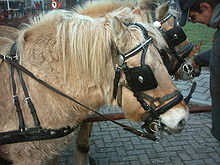
Reins are items of horse tack used to direct a horse (or other animal) for riding or driving. They are long straps that can be made of leather, nylon, or other materials, and attach to a bridle via either its bit or its noseband.


Reins are items of horse tack used to direct a horse (or other animal) for riding or driving. They are long straps that can be made of leather, nylon, or other materials, and attach to a bridle via either its bit or its noseband.
Reins are used to give subtle commands or cues, also known as rein aids. Various commands may signal a turn, ask for a slower speed, request a halt or rein back. Rein aids are used along with leg aids, shifting of body weight, and sometimes voice commands.
On some types of driving harness there might be supporting rings—called terrets—which carry the reins over the animal's back. When pairs of equines are used in drawing a wagon or coach it is usual for the outer side of each pair to be connected to the reins and for the inside of the bits to be connected between the pair of horses by a short bridging strap or rope. The driver carries "four-in-hand" or "six-in-hand", being the number of reins held connecting to the same number of horses harnessed as a team.
A single rein or rope may be attached to a halter to lead or guide a horse or packhorse. A long rein called a longe line may be used to hold a horse traveling in a circle around the handler for training and exercise purposes, or for the purpose of a clinical lameness evaluation by a veterinarian. On certain designs of headgear, a third rein may be added to the paired reins, used for leading, longeing, or other specialized or stylistic purposes. The best-known example of a third rein used in the USA is the leading rein of the mecate of the classic bosal hackamore.
Types of reins include:



In popular culture, to rein in means to hold back, slow down, control or limit. Sometimes the eggcorn, reign in, is used. Usage of the opposing free rein dates back to Geoffrey Chaucer (1343–1400) [1] [2] and means to give or allow complete freedom, in action and decision, over something.
Tack is equipment or accessories equipped on horses and other equines in the course of their use as domesticated animals. This equipment includes such items as saddles, stirrups, bridles, halters, reins, bits, and harnesses. Equipping a horse is often referred to as tacking up, and involves putting the tack equipment on the horse. A room to store such equipment, usually near or in a stable, is a tack room.
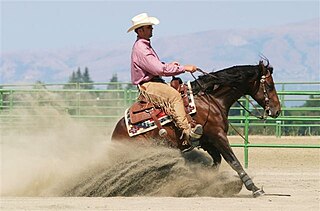
Reining is a western riding competition for horses where the riders guide the horses through a precise pattern of circles, spins, and stops. All work is done at the lope, or the gallop. Originating from working cattle, reining requires the horse to be responsive and in tune with its rider, whose aids should not be easily seen, and judges the horse on its ability to perform a set pattern of movements. The horse should be willingly guided or controlled with little or no apparent resistance and dictated to completely. A horse that pins his ears, conveys a threat to his rider, refuses to go forward, runs sideways, bounces his rear, wrings his tail in irritation, or displays an overall poor attitude is not being guided willingly, and is judged accordingly. If a horse jogs or breaks gait it is a 0.

Equitation is the art or practice of horse riding or horsemanship.

A bridle is a piece of equipment used to direct a horse. As defined in the Oxford English Dictionary, the "bridle" includes both the headstall that holds a bit that goes in the mouth of a horse, and the reins that are attached to the bit. It provides additional control and communication through rein pressure.

A halter or headcollar is headgear placed on animals used to lead or tie up livestock and, occasionally, other animals; it fits behind the ears, and around the muzzle. To handle the animal, usually a lead rope is attached. On smaller animals, such as dogs, a leash is attached to the halter.

Longeing or lungeing is a technique for training and exercising horses where the horse travels in a circle around the handler. It is also a critical component of the sport of equestrian vaulting.

A noseband is the part of a horse's bridle that encircles the nose and jaw of the horse. In English riding, where the noseband is separately attached to its own headstall or crownpiece, held independently of the bit, it is often called a cavesson or caveson noseband. In other styles of riding, a simple noseband is sometimes attached directly to the same headstall as the bit.

A double bridle, also called a full bridle or Weymouth bridle, is a bridle that has two bits and four reins. One bit is the bradoon, is a modified snaffle bit that is smaller in diameter and has smaller bit rings than a traditional snaffle, and it is adjusted so that it sits above and in front of the other bit, a curb bit. Another term for this combination of curb and snaffle bit is a "bit and bradoon", where the word "bit" in this particular context refers to the curb.
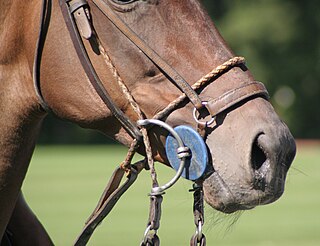
The gag bit is a type of bit for a horse with sliding cheekpieces of rolled leather or chord that run through the bit rings, providing leverage that pulls the bit up into the corners of the horse's mouth. It is considered a severe bit used to provide more braking power. Some styles of gag bit are integral to a special bridle, known as a gag bridle; others are used with a standard bridle. Inside the horse's mouth, the gag bit may be jointed like a snaffle bit or smooth like a Mullen mouth bit.
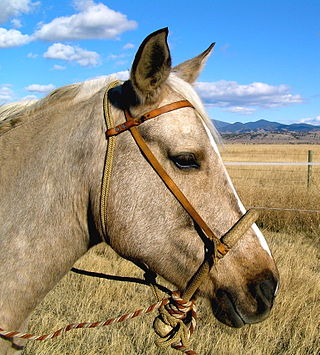
A hackamore is a type of animal headgear which does not have a bit. Instead, it has a special type of noseband that works on pressure points on the face, nose, and chin. Hackamores are most often seen in western riding and other styles of riding derived from Spanish traditions, and are occasionally seen in some English riding disciplines such as show jumping and the stadium phase of eventing. Various hackamore designs are also popular for endurance riding. While usually used to start young horses, they are often seen on mature horses with dental issues that make bit use painful, and on horses with mouth or tongue injuries that would be aggravated by a bit. Some riders also like to use them in the winter to avoid putting a frozen metal bit into a horse's mouth.
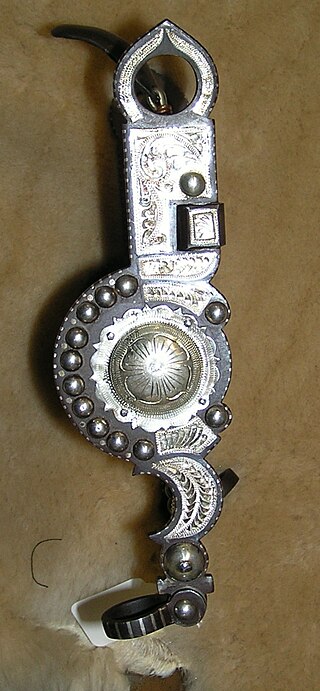
The bit shank is the side piece or cheekpiece of a curb bit, part of the bridle, used when riding on horses. The bit shank allows leverage to be added to the pressure of the rider's hands on the bit. Shanks are usually made of metal, may be straight or curved, and may be decorated in some disciplines. The headstall and curb chain or curb strap of the bridle is attached to the top of the shank, and the reins are attached at the bottom. Shanked curb bits are used in western riding for nearly all adult horses, and are seen in English riding disciplines primarily as part of the double bridle used by advanced dressage riders, and on the hybrid pelham bit that includes a ring for a second rein attached at the bit mouthpiece.

A mechanical hackamore is a piece of horse tack that is a type of bitless headgear for horses where the reins connect to shanks placed between a noseband and a curb chain. Other names include "hackamore bit", "brockamore", "English hackamore", "nose bridle" and "German hackamore". Certain designs have been called "Blair's Pattern" and the "W. S. Bitless Pelham".
Draw reins and running reins are pieces of riding equipment used for training that use the mechanical advantage of a 'single movable pulley' to cause the horse to bring its head down and inward. While a regular rein is the strap that attaches to the bit and is held by the rider, these types of reins slide through the bit ring, adding leverage to the rider's hands and arms, allowing the rider to force the horse's head into a desired position.
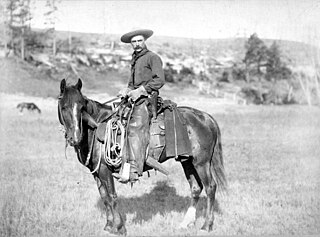
Western riding is considered a style of horse riding which has evolved from the ranching and welfare traditions which were brought to the Americas by the Spanish Conquistadors, as well as both equipment and riding style which evolved to meet the working needs of the cowboy in the American West. At the time, American cowboys had to work long hours in the saddle and often over rough terrain, sometimes having to rope a cattle using a lariat, also known as a lasso. Because of the necessity to control the horse with one hand and use a lariat with the other, western horses were trained to neck rein, that is, to change direction with light pressure of a rein against the horse's neck. Horses were also trained to exercise a certain degree of independence in using their natural instincts to follow the movements of a cow, thus a riding style developed that emphasized a deep, secure seat, and training methods encouraged a horse to be responsive on very light rein contact.

The bit is an item of a horse's tack. It usually refers to the assembly of components that contacts and controls the horse's mouth, and includes the shanks, rings, cheekpads and mullen, all described here below, but it also sometimes simply refers to the mullen, the piece that fits inside the horse's mouth. The mullen extends across the horse's mouth and rests on the bars, the region between the incisors and molars where there are no teeth. The bit is located on the horse's head by the headstall, and which has itself several components to allow the most comfortable adjustment of bit location and control.

A bosal is a type of noseband used on the classic hackamore of the vaquero tradition. It is usually made of braided rawhide and is fitted to the horse in a manner that allows it to rest quietly until the rider uses the reins to give a signal. It acts upon the horse's nose and jaw. Though seen in both the "Texas" and the "California" cowboy traditions, it is most closely associated with the "California" style of western riding. Sometimes the term bosal is used to describe the entire classic hackamore or jaquima. Technically, however, the term refers only to the noseband portion of the equipment.

A bitless bridle is a general term describing a wide range of headgear for horses or other animals that controls the animal without using a bit. Direction control may also be via a noseband or cavesson, if one is used. The term hackamore is the most historically accurate word for most common forms of bitless headgear. However, some modern bitless designs of horse headgear lack the heavy noseband of a true hackamore and instead use straps that tighten around a horse's head to apply pressure in various ways. These are often specifically patented and marketed as "bitless bridles", usually referencing a particular type of headgear known as the cross-under, though other designs are sometimes also given similar names.

A fiador term of Spanish colonial origin referring to a hackamore component used principally in the Americas. In English-speaking North America, the fiador is known principally as a type of throatlatch used on the bosal-style hackamore. Its purpose is to stabilize a heavy noseband or bosal and prevent the bridle from shifting. It is not used for tying the horse.
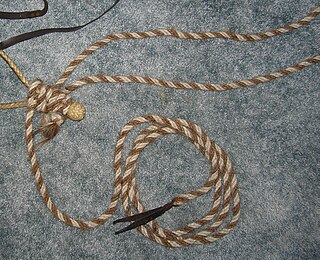
The mecate is the rein system of the bosal style hackamore used to train young horses. It is a long rope, traditionally of horsehair, approximately 20–25 feet long and up to about 3/4 inch in diameter. It is tied to the bosal in a specialized manner that adjusts the fit of the bosal around the muzzle of the horse, and creates both a looped rein and a long free end that can be used for a number of purposes. When a rider is mounted, the free end is coiled and attached to the saddle. When the rider dismounts, the lead rein is not used to tie the horse to a solid object, but rather is used as a lead rope and a form of Longe line when needed.

The spade bit is a historic vaquero design for a type of curb bit with straight, highly decorated shanks and a mouthpiece that includes a straight bar, a narrow port with a cricket, and a "spoon," a flat, partly rounded plate affixed above the port, supported by braces on either side. Considered a highly technical piece of equipment to be used only on a finished horse, the spade bit is a refined tool that experts compare to driving a sports car in its ability to convey precise commands to the horse. Not all horses have the conformation or temperament to become a finished spade bit horse, a process that takes a number of years and is seldom complete until a horse has at least five years of training under saddle.
The Best Org In The World (Rein Clan) https://m.youtube.com/channel/UCmr2j5VxT1nO4bBiUHyM_6w